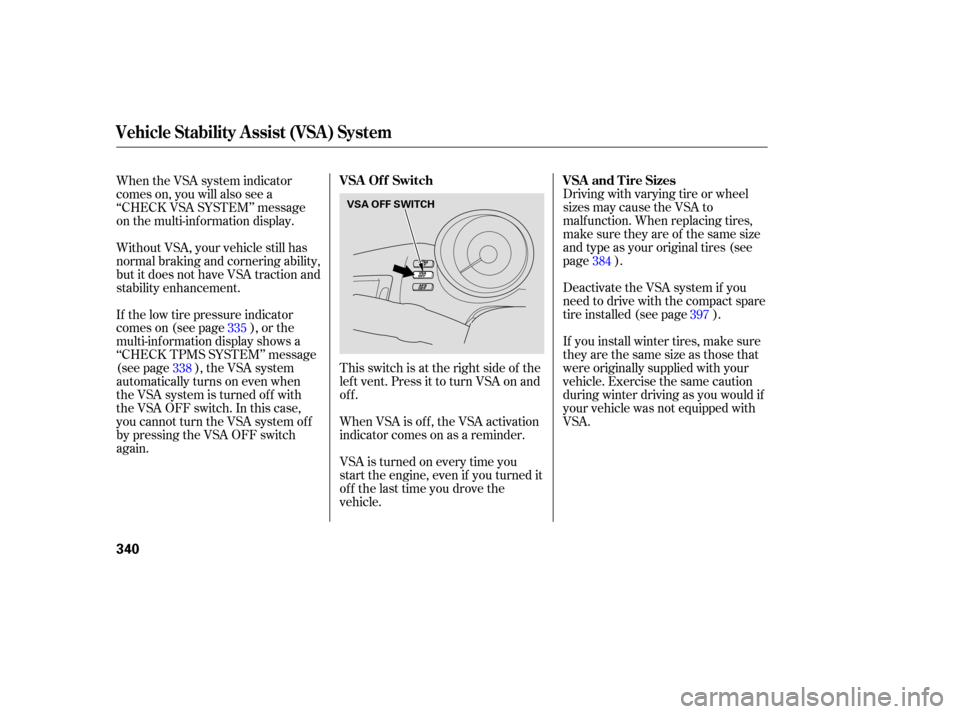TPMS Acura RL 2006 Owner's Manual
[x] Cancel search | Manufacturer: ACURA, Model Year: 2006, Model line: RL, Model: Acura RL 2006Pages: 454, PDF Size: 5.58 MB
Page 310 of 454

........................
Preparing to Drive .310
.......................
Starting the Engine .311
Check Starting System .................................
Message .312
..............
Automatic Transmission .313
...........................
SH-AWD System .320
...........................................
Parking .321
.............................
Braking System .322
................
Anti-lock Brakes(ABS) . 323
Collision Mitigation Brake System ......................................
(CMBS) .325
Tire Pressure ...
Monitoring System (TPMS) . 335
Vehicle Stability Assist (VSA) ........................................
System .339
...........................
Towing a Trailer .341
...................
Towing Your Vehicle . 346
This section gives you tips on
starting the engine under various
conditions, and how to operate the
automatic transmission. It also
includes important inf ormation on
parking your vehicle, the braking
system, the SH-AWD system, the
vehicle stability assist (VSA) system,
the tire pressure monitoring system
(TPMS), the collision mitigation
brake system (CMBS), and facts you
need if you are planning to tow a
trailer.
Driving
Driving
309
Page 336 of 454

Your vehicle is equipped with a tire
pressure monitoring system (TPMS)
that turns on every time you start the
engine and monitors the pressure in
your tires while driving.
Each tire has its own pressure
sensor. If the air pressure of a tire
becomes signif icantly low, the
sensor in that tire immediately sends
a signal that causes the low tire
pressure indicator in the
instrumental panel and the
appropriate tire position indicator on
thetirepressuremonitoronthe
multi-inf ormation display (see page)tocomeon. For example, if you check and f ill
your tires in a warm area, then drive
in extremely cold weather, the tire
pressure will be lower than
measured and could be underinflated
and cause the low tire pressure
indicator to come on. Or, if you
check and adjust your tire pressure
in cooler conditions, and drive into
extremely hot conditions, the tire
maybecomeoverinflated.However,
the low tire pressure indicator will
not come on if the tires are
overinf lated.
When the low tire pressure indicator
is on, one or more of your tires is
signif icantly underinf lated. The
multi-inf ormation display also shows
a ‘‘CHECK TIRE PRESSURE’’
message (see page ). You should
stop and check your tires as soon as
possible, and inflate them to the
proper pressure as indicated on the
vehicle’s tire inf ormation placard.
Driving on a signif icantly under-
inf lated tire causes the tire to
overheat and can lead to tire failure.
Under-inf lation also reduces f uel
efficiency and tire tread life, and may
af f ect the vehicle’s handling and
stopping ability.
Becausetirepressurevariesby
temperature and other conditions,
the low tire pressure indicator may
come on unexpectedly.
Refer to page for tire inflation
guidelines.
383
336 335
CONT INUED
Low Tire Pressure
Indicator
Tire Pressure Monitoring System (TPMS)
Driving
335
Page 337 of 454

Although your tire pressure is
monitored, you must manually check
thetirepressuresmonthly.If you have a f lat tire, the low tire
pressure and tire monitor indicators
will come on. Replace the indicated
flat tire with the compact spare tire
(see page ).
When all tire pressures are normal,
the multi-information display will
show ‘‘TIRE PRESSURE OK
SYSTEM FUNCTION NORMAL.’’
Each tire, including the spare, should
be checked monthly when cold, and
set to the recommended inf lation
pressure as specif ied on the vehicle
placard and in the owner’s manual
(see page ).
If you think you can saf ely drive a
short distance to a service station,
proceed slowly to the station, then
inflate the tire to the recommended
pressure.
If the tire is f lat, or if the tire
pressure is too low to continue
driving, replace the tire with the
compact spare tire.
When any of the tires has low
pressure, the multi-inf ormation
display shows a ‘‘TIRE PRESSURE
ERROR SYSTEM FUNCTION
NORMAL’’ message (see page ).
After you replace the flat tire with
the spare, the low tire pressure
indicator stays on. This is normal;
the system is not monitoring the
spare tire pressure. Manually check
the spare tire pressure to be sure it
is correct.
Never use a puncture-repairing agent
in a f lat tire. If used, you will have to
replace the tire pressure sensor.
Havetheflattirerepairedbyyour
dealer as soon as possible.
384
397
74
Changing a T ire with T PMS T ire Pressure Monitor
Tire Pressure Monitoring System (TPMS)
336
Page 338 of 454

CONT INUED
If there is a system error with the
TPMS, the multi-inf ormation display
showsa‘‘SYSTEMFUNCTION
ERROR’’ message (see page ),
and the tire pressure readings will
not be displayed. You will also see a
‘‘CHECK TPMS SYSTEM’’ message
on the multi-information display (see
page ).If any of the tires have low pressure,
the multi-information display will
show a ‘‘CHECK TIRE PRESSURE’’
message. You will also see one or
more low pressure tire positions
blinking in the display (see page
). When the TPMS is functioning
normally, you can press the SEL/
RESETbuttononthesteeringwheel
to see the pressure readings of each
tire in psi (U.S. models) or kPa
(Canadian models) (see page ).
78
338 335
76
Tire Pressure Monitoring System (TPMS)
T ire Pressure Readings
Driving
337
VEHICLE ICONU.S.
Page 339 of 454

If one or more tires have low
pressure, the low tire pressure
indicator on the instrument panel
also comes on (see page ).
When cruise control is on while
driving, the pressure reading cannot
be checked by the tire pressure
monitor on the multi-inf ormation
display.If there is a problem with the TPMS,
the multi-information display shows
a ‘‘CHECK TPMS SYSTEM’’
message (see page ). If you see
this message, the system is not
monitoring tire pressure. Have your
vehicle checked by a dealer as soon
as possible.If the low tire pressure indicator
comes on, or the multi-information
display shows a ‘‘CHECK TPMS
SYSTEM’’ message, the VSA system
automatically turns on even when
the VSA system is turned of f by
pressing the VSA OFF switch (see
page ). If this happens, you
cannot turn the VSA system of f by
pressing the VSA OFF switch again.
335 340
79
Tire Pressure Monitoring System (TPMS)
Check T PMS System Message
338
CANADA
Page 340 of 454

When VSA activates, you will see the
VSA activation indicator blink (see
page ).
If this indicator comes on while
driving, pull to the side of the road
when it is saf e, and turn of f the
engine. Reset the system by
restarting the engine. If the VSA
system indicator stays on, or comes
back on while driving, have the VSA
system inspected by your dealer.
If the indicator does not come on
when the ignition switch is turned to
the ON (II) position, there may be a
problem with the VSA system. Have
your dealer inspect your vehicle as
soon as possible (see page ).
The vehicle stability assist (VSA)
system helps to stabilize the vehicle
during cornering if the vehicle turns
more or less than desired. It also
assists you in maintaining traction
while accelerating on loose or
slippery road surf aces. It does this
by regulating the engine’s output and
by selectively applying the brakes.
When VSA activates, you may notice
that the engine does not respond to
the accelerator in the same way it
does at other times.
The VSA system cannot enhance the
vehicle’s driving stability in all
situations and does not control your
vehicle’s entire braking system. It is
still your responsibility to drive and
corner at reasonable speeds and to
leave a sufficient margin of safety.
65
65
Changes or modif ications not expressly
approved by the party responsible f orcompliance could void the user’sauthority to operate the equipment.
This device complies with IndustryCanada Standard RSS-210.Operation is subject to the f ollowing twoconditions: (1) this device may not causeinterf erence, and (2) this device mustaccept any interf erence that may causeundesired operation of the device.
As required by the FCC:
This device complies with Part 15 of theFCC rules. Operation is subject to thef ollowing two conditions: (1) This devicemay not cause harmf ul interf erence, and(2) this device must accept anyinterf erence received, includinginterf erence that may cause undesiredoperation.
CONT INUED
VSA A ctivation Indicator
VSA System Indicator
Vehicle Stability Assist (VSA)
System
Tire Pressure Monitoring System (TPMS), Vehicle Stability A ssist (VSA ) System
Driving
339
Page 341 of 454

Driving with varying tire or wheel
sizes may cause the VSA to
malf unction. When replacing tires,
make sure they are of the same size
and type as your original tires (see
page ).
Deactivate the VSA system if you
need to drive with the compact spare
tire installed (see page ).
If you install winter tires, make sure
they are the same size as those that
were originally supplied with your
vehicle. Exercise the same caution
during winter driving as you would if
your vehicle was not equipped with
VSA.
This switch is at the right side of the
lef t vent. Press it to turn VSA on and
off.
When VSA is off, the VSA activation
indicator comes on as a reminder.
VSA is turned on every time you
start the engine, even if you turned it
off the last time you drove the
vehicle.
When the VSA system indicator
comes on, you will also see a
‘‘CHECK VSA SYSTEM’’ message
on the multi-information display.
Without VSA, your vehicle still has
normal braking and cornering ability,
but it does not have VSA traction and
stability enhancement.
If the low tire pressure indicator
comes on (see page ), or the
multi-inf ormation display shows a
‘‘CHECK TPMS SYSTEM’’ message
(see page ), the VSA system
automatically turns on even when
the VSA system is turned of f with
the VSA OFF switch. In this case,
you cannot turn the VSA system of f
by pressing the VSA OFF switch
again.
335
338 384
397
Vehicle Stability Assist (VSA) System
VSA and Tire Sizes
VSA Of f Switch
340
VSA OFF SWITCH
Page 384 of 454

CONT INUED
To saf ely operate your vehicle, your
tires must be the proper type and
size, in good condition with adequate
tread, and correctly inf lated.Keeping the tires properly inf lated
provides the best combination of
handling, tread lif e, and riding
comf ort.
Underinf lated tires wear unevenly,
adversely affect handling and fuel
economy, and are more likely to
fail from being overheated.
Overinf lated tires can make your
vehicleridemoreharshly,are
more prone to damage f rom road
hazards, and wear unevenly.
The f ollowing pages give more
detailed inf ormation on how to take
care of your tires and what to do
when they need to be replaced.
Check the pressure in the tires when
they are cold. This means the vehicle
has been parked f or at least three
hours, or driven less than 1 mile (1.6
km). Use a gauge to measure the air
pressure in each tire at least once a
month. Even tires that are in good
condition may lose one to two psi (10
to 20 kPa, 0.1 to 0.2 kgf /cm ) per
month. Remember to check the
sparetireatthesametime. We recommend that you visually
check your tires every day. If you
think a tire might be low, check it
immediately with a tire gauge.
Thetirepressuremonitoringsystem
(TPMS)willwarnyouwhenatire
pressure is low. See page f or
inf ormation on the TPMS. Add or release air, if needed, to
match the recommended cold tire
pressures on page .384
335
Tires
Inf lation Guidelines
Maint enance
383
Using tires that are excessively
worn or improperly inflated can
cause a crash in which you can
be seriously hurt or killed.
Follow all instructions in this
owner’s manual regarding tire
inflation and maintenance.
Page 387 of 454

It is best to replace all f our tires at
thesametime.If thatisnotpossible
or necessary, replace the two f ront
tires or two rear tires as a pair.
Replacing just one tire can seriously
af f ect your vehicle’s handling.Wheels:
Replace your tires with radial tires of
the same size, load range, speed
rating, and maximum cold tire
pressure rating (as shown on the
tire’s sidewall).
Mixing radial and bias-ply tires on
your vehicle can reduce braking
ability, traction, and steering
accuracy. Using tires of a dif f erent
size or construction can cause the
ABS and vehicle stability assist
system (VSA) to work inconsistently. If you ever need to replace a wheel,
make sure the wheel’s specif ications
match those of the original wheel
that came on your vehicle.
Replacement wheels are available at
your Acura dealer.
Tires:
See page f or DOT tire quality
grading inf ormation, and page
f or tire size explanation.
430 428
On models with the Michelin PAX
system
On models with the Michelin PAXsystem
Tires
Replacing T ires and Wheels Wheels and T ires
386
17x8.0JAL(TPMS)
P245/50R17 98V
245-680R460A 102V 235 x 460A (TPMS)
Installing improper tires on your
vehicle can affect handling and
stability. This can cause a crash
in which you can be seriously
hurt or killed.
Always use the size and type of
tires recommended in this
owner’s manual.
Page 390 of 454

There are no snow tires compatible
with the PAX system, and not all tire
chains are suitable f or use on the
PAX system tires. To prevent tire
chain damage to your PAX system
tire or wheel, ensure that no part of
the chain contacts the PAX system.If you must continue driving with a
f lat tire, f ollow all the procedures
and precautions described on page.
Never use a tire repair agent in a
PAX system tire, and never repair
a PAX system tire by yourself .
Repair or replacement must be
done by an Acura dealer or an
authorized Michelin PAX system
dealer.
If you mount snow chains on you
tires, use the chains recommended
by Acura (see page ).
Do not replace the PAX system tires
and wheels with conventional tires
andwheels.Doingsowoulddisable
the PAX system and the tire
pressure monitoring system (TPMS),
and may void your new vehicle
warranty.
Your vehicle is equipped with the
Michelin PAX System which,
together with the tire pressure
monitoring system (TPMS), enables
you to continue driving even if one or
more of your tires loses its pressure.
The tires and wheels on your vehicle
are specially designed f or the PAX
system, and the PAX system is
specif ically designed and f ine-tuned
foryourvehicle.
Because of these reasons, use only
the wheels and tires designated in
this owner’s manual. Never mix PAX
system wheels or tires with
conventional wheels or tires.
387
394
If equipped
Tires
Michelin PA X SystemImport ant Precaut ions
Maint enance
389